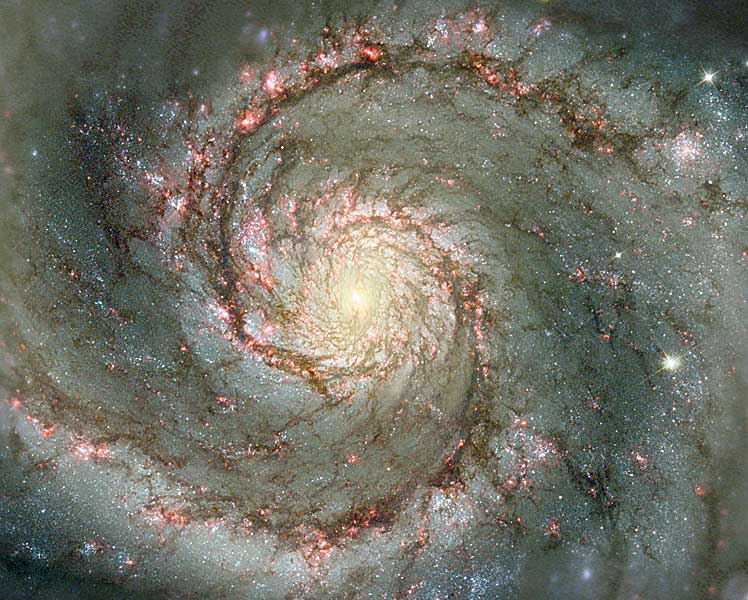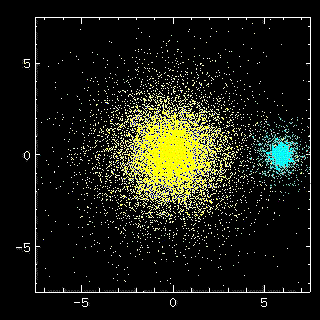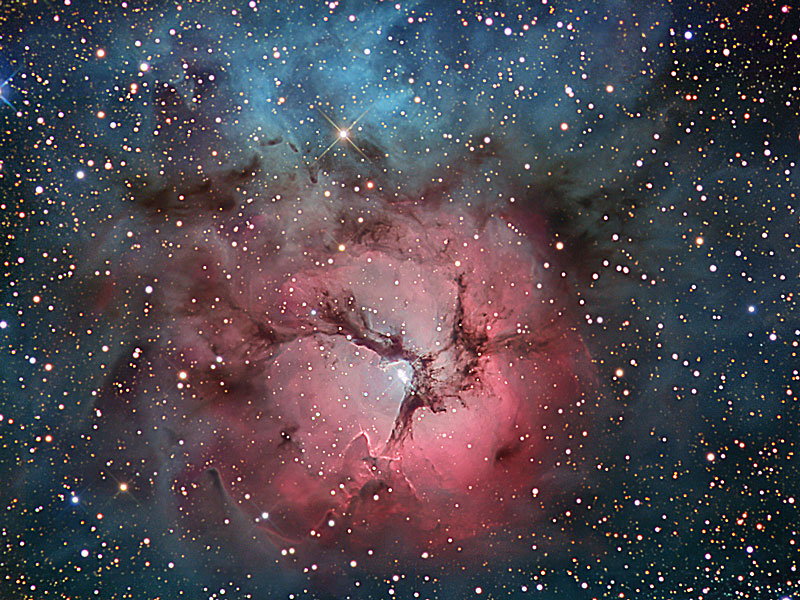SITES of STAR FORMATION
|
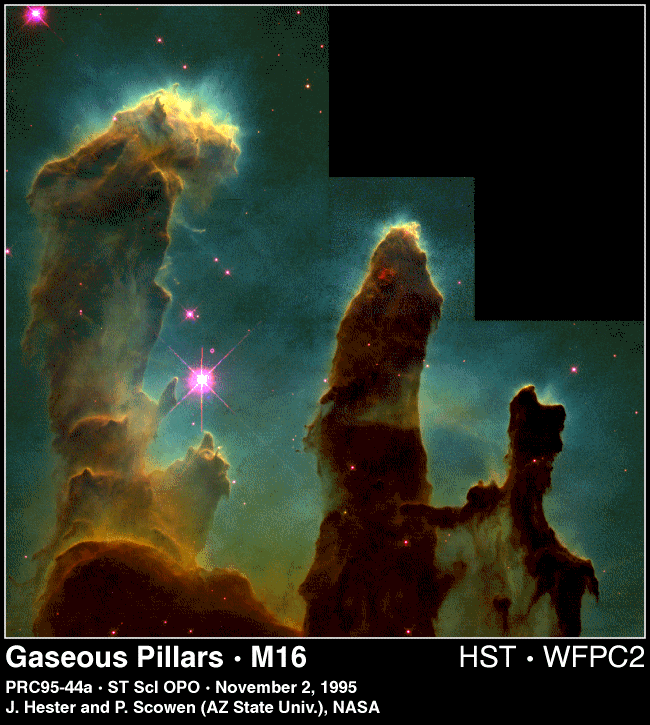
|
STARS FORM NEAR THE ARMS OF OUR GALAXY
How do we know this to be true?
(1) We must first argue how we can determine whether
spiral arms and star formation are somehow connected.
How will we do this?
(2)We must then demonstrate how we can show where star formation occurs in
our Galaxy (which means that we must
know how to recognize regions where star formation is ongoing).
We address the first issue now.
The spiral arms in a disk galaxy (as seen in the Whirlpool Galaxy, M51)
are, in many instances, compression waves which move
through the disk of the galaxy. Many different mechanisms have been
proposed as mechanisms for
the formation of spiral arms; the panel on the right shows one plausaible
model where an interaction with a nearby galaxy excites spiral arms in
the galaxy (which may be the mechanism which formed the spiral arms in M51).
Spiral arms are wave-like in nature and thus not solid structures; they
move with respect to the underlying gas and dust in the disk of the Galaxy
(say, like a sound wave moves through the air in this room). In our
Galaxy near the location of the Sun, spiral arms move through the disk
at around 20 kilometers per second.
So, in 1 million years, a spiral arm moves around
65 light years with respect to the disk material. This is
nothing compared to the size of our Galaxy; the stellar disk
of our Galaxy is around 100,000 light years in diameter.
We know that massive stars have short lifetimes--for example, a 20 Solar mass
star lives for only a few million years. Thus, such massive stars indicate
recent star formation and thus mark star formation regions. If we see O and B
stars distributed uniformly throughout the disk of our Galaxy this would
mean that star formation occurs everywhere in our Galaxy. Is this true?
It is observed that massive stars
cluster around the spiral arms of our Galaxy ==> star formation
is associated with the spiral arms of our Galaxy.
How did we infer that hot, massive stars (O & B stars) cluster around
spiral arms? Well, in some instances, we see clusters of stars known as
O & B Associations. O & B associations are young stellar clusters (a few
million years or so in age) composed of 10-100 stars
with diameters on the order of a few hundred
light years. There are around 70 OB associations in our Galaxy.
In addition, we identify signatures of star formation
and then check to see if star formation regions cluster around the spiral
arms of our Galaxy.
What are the Signatures of Star Formation?
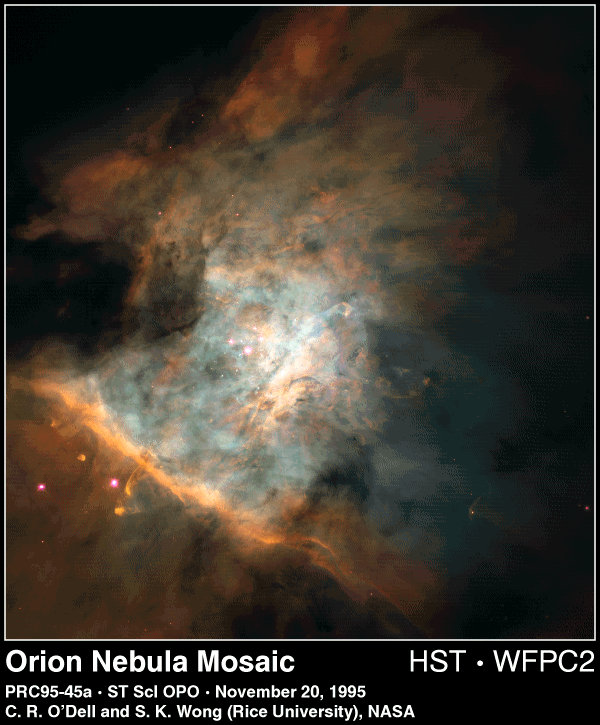 |
Star Formation Occurs in objects known as
Giant Molecular Clouds (GMC).
Giant Molecular Clouds (GMCs)
are large gas clouds composed primarily of H2,
molecular hydrogen gas. They have huge masses, 10,000 to 10,000,000
Solar masses and large sizes, tens of light years in diameter. GMCs
are fairly dense 100 to several million molecules atoms per cubic
centimeter. A cubic centimeter is roughly the volume of a sugar cube.
For comparison, the density of air in this room is roughly
1018-1019 molecules per cubic
centimeter, and the average density of particles in our Galaxy (outisde
of these dense clouds) is
around 1 atom per cubic centimeter. GMCs are thus much more rarefied than
the air in this room, but they are much denser than the average region in
the Mikly Way Galaxy. GMCs are also very cold T ~ 10-20 Kelvin.
GMCs also contain dust. Although there are only tiny amounts of dust,
the dust is an efficient absorber and scatterer of visible light and so
prevents us from seeing star forming regions inside of GMCs
and it is difficult to study GMCs in the optical; the dust does not
affect IR and
microwaves and so they offer the best views of the star formation
process.
The most nearby example
of a GMC is in the constellation of
Orion, the
Orion Molecular Cloud.
|
The primary markers of star formation are
H II regions (gas clouds of ionized hydrogen),
O & B star associations and reflection nebulae,
and the Giant Molecular Clouds (GMCs) themselves.
(Also found near spiral arms are
H I clouds, neutral hydrogen gas clouds).
To get a handle on how these clouds fit together, I next
describe the material which resides between the stars of our
Galaxy, the material known as the
INTERSTELLAR MEDIUM, the ISM.
The Interstellar Medium (ISM)
The Milky Way
galaxy has a total mass > 100 billion Solar masses.
The material in-between the stars (the Interstellar Medium)
contains ten or so billion Solar masses -- the gas and dust are thus
about 10-15 % of the visible
mass of our Galaxy. This gas and dust are, however, quite
important as they are the material out of which stars form.
Make-Up of the ISM
- The ISM material is primarily gas:
- it is roughly
90 % hydrogen and 10 % helium, with just a touch of everything else.
- The
dust is very rare. Dust particles are
complexes of several billion atoms; they are usually
composed of carbon (graphite) and silicates.
This means that dust makes a very small contribution
to the mass of the ISM (< 1 %) and that it makes an even smaller
contribution to the number of particles in the ISM.
Structure of the ISM
The gas and dust are not spread uniformly throughout the Milky Way.
They are mostly confined to the disk of the Galaxy. Furthermore, they are
not spread uniformly throughout the disk. The ISM is lumpy. We have:
- Coronal gas -- dilute gas at temperatures of
around 3x105 K, which fills roughly 70 % of the volume of the
disk. The coronal gas has very low density -- around 0.01 % to 1 %
of the average
ISM density -- and so does not make a significant contribution
to the gas and dust mass of our Galaxy (~ 0.1 %). The coronal gas is
heated by supernova shocks.
- Neutral hydrogen Clouds (H I regions). The H I clouds have sizes
of ~15 light years, masses of ~ 100 M(sun), T ~ 50 - 100 K,
and densities of tens of millions of particles per cubic meter. They
make up roughly 40 % of the mass in the gas and dust but only a couple of
percent of the volume of the ISM. HI regions do not shine by starlight.
They produce something known as 21-centimeter Radiation:
radio emission from hydrogen which arises when the
electron flips its spin.
This is a critical technique for
seeing the ISM which is dominated
by neutral hydrogen, HI.
- Giant Molecular Clouds (GMC)
-- It is well-established that GMCs
are the clouds in which star formation occurs.
(Giant Molecular Clouds:
Orion,
Orion
nebula,
Orion mosaic,
,
Video 1,
You tube Flythrough).
GMC's are actually complexes of smaller clumps of material:
- small dense clumps
of material composed mainly of hydrogen molecules (H2)
with:
- T ~ 10-100 K
- densities of 100 million to
biilions of particles per
cubic meter
- sizes of 10s of light years
- masses of 104 to 107 M(sun) -- 105M(sun)
is typical
Although striking in appearance, GMCs fill only several hundredths of 1 percent
of the volume of the ISM.
Where the interstellar medium is cold and dense, molecules form (hence the
name GMC). Molecules play an important not only in the structure of the ISM
but also for the study of the ISM.
- Molecules may emit radio signals, the
wavelength of which indicates from which molecule it comes. For example,
- Hydroxyl OH
- Water H2O
- Ammonia NH3
-
Formaldehyde H2CO
- Carbon monoxide CO - useful for spiral arm study
- Molecular hydrogen H2
- Hydrogen isoCyanide HCN - see cloud around center of Milky Way
- Hydrogen is the overwhelmingly dominant component, but it is harder to
observe, and the other molecules are the observed tracers of the accumulation
- These radio signals, in addition to the IR that arises from the
dust, serve as sensitive probes of
star forming regions in GMCs.
- Ionized Hydrogen Clouds (HII regions).
(Eagle
nebula,
Eagle
nebula HST).
H II region mark sites of massive star
formation.
Massive stars (O & B stars) are very hot and so produce large
amounts of UV radiation. UV radiation is capable of ionizing hydrogen gas.
Lower mass stars are not hot enough to produce large amounts of UV and so
do not form large H II regions.
Associated with spiral arms and GMCs. These
are the red, glowing pictures that you see in the text. They glow red
because they radiate large amounts of hydrogen balmer alpha lines (which
fall in the red portion of the spectrum) which forms as the ionized hydrogen
gas (H II) recombines to form neutral atoms and radiates. H II regions
have temperatures on the order or 8,000-10,000 Kelvin with densities of
0.1 to 10,000 particles per cubic centimeter. They fill much less than 1 %
of the volume of the ISM.
- Reflection Nebulae (e.g.,
Pleiades), form around massive, hot stars.
One
sees the reflection of blue light by the dust particles in the cloud.
|
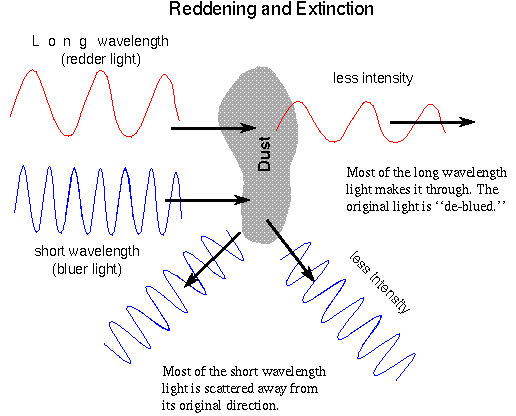 |
The dust scatters blue light toward us while the
red light streams straight through the dusty region.
- Dark clouds are regions of high dust concentration. The dust very
effectively blocks out the stars which sit behind them making what appears
to be a hole in the sky.
Ultraviolet radiation has helped in the study of the ISM allowing a
map of our local cosmic neighborhood to be formed.
Ultraviolet radiation can only be studied by instruments placed in orbit
above the Earth's atmosphere
The International Ultraviolet Explorer (IUE) found a number of
regions of interstellar space that are much thinner (5000 atoms/m3)
and hotter (500,000 K) than expected
The Sun resides in the so-called
Local Bubble, a region
- about 100 pc across, containing about 200,000 stars
- thought to have been carved out by multiple supernova explosions several hunderd thousand years ago
- Such supernovae would have been spectacular events in the sky


